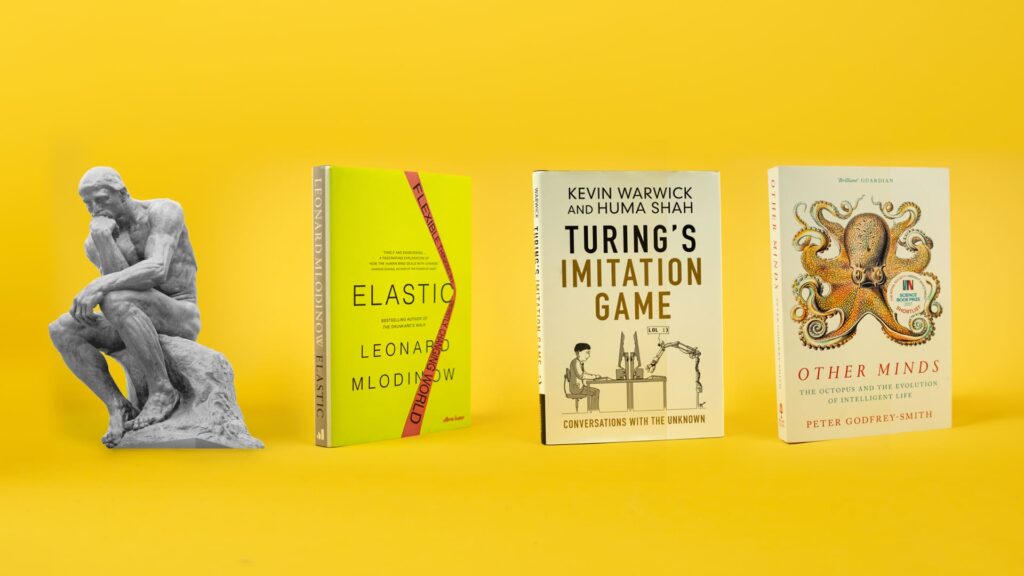"What do Pokemon Go and Mary Shelley’s Frankenstein have in common?
Why do some businesses survive and others fail at the first sign of change?
What gives the human brain the edge over computers?
The answer: Elastic Thinking."
– Elastic: Flexible Thinking in a Constantly Changing World, Leonard Mlodinow
In his book, Elastic: Flexible Thinking in a Constantly Changing World, Leonard Mlodinow posits that elastic thinking is what the world needs more than ever as change and challenges come at us from all directions. In creating brands, we couldn’t agree more that elastic thinking is the best way to unlock the magic. The book outlines three levels of thinking: scripted, analytical and elastic, and argues that elastic thinking is the most valuable. Here, we take a look at this and explore what each of these levels of thinking involves and why elastic thinking is so special.

Scripted Thinking
Let’s begin with what thinking is: the dictionary defines it as ‘the process of considering or reasoning about something’. Another definition states that ‘thinking is everything that the conscious mind does, including perception, mental arithmetic, remembering a phone number, or conjuring up images in our mind’. As described by Mlodinow, the simplest form of thinking is scripted thinking, which largely involves input and response. He continues by explaining that scripted thinking is an efficient way for nature to deal with repetitive situations often related to mating, nesting and killing prey. It is appropriate in routine situations as it produces a fixed response (and thus often fails in circumstances of novelty or change).
A dog barks, and a cat runs away. A predator hunts, and its prey tries to hide. Animals certainly exhibit scripted behaviour, but they can be capable of further complexity too. While dogs, cats, dolphins and monkeys are often considered on the upper end of animal intelligence there is an overlooked creature that deserves special mention. In his book Other Minds, Peter Godfrey explores the exotic world of the octopus and it’s very unusual ‘mind’. About 600 million years ago, cephalopods took an evolutionary departure from us and developed a mind completely different from humans, cats, dogs, chimpanzees or dolphins. If we could communicate with them, it would truly be our closest attempt at contacting alien life.
Human brains communicate with the rest of the body through the central nervous system via neurons. Much of an octopus’s nervous system, however, is not found within the brain at all – their arms actually have twice as many neurons, and they also have sensors in their legs which can smell and taste. They often engage in complex hunting that requires more manipulation and exploration than other animals are capable of, and the number of neurons found in their bodies has increased to control and coordinate all eight arms to allow for these complicated processes to take place. Human interaction with the world is shaped by how our bodies have evolved for different abilities, such as walking; octopuses’ capabilities are totally different, and therefore they also see the world with a different psychology, living outside any normal understanding of a brain and body. Where this creature fits into traditional ideas of intelligence and thinking appears to be open for more study and is certainly intriguing.
Not limited to animals, though, humans also employ scripted thinking in a number of ways; ‘going on autopilot’, for example, involves carrying out an action over time and arriving at a destination without really paying attention to how you got there. Another example is dogma – a belief system that doesn’t consider other options, whether it be religious or philosophical. In any dialogue that concerns or involves dogma, the person can only repeat learned ideas and phrases without ever really examining their validity. Scripted thinking even arises in social situations where one might expect some complexity: consider the standard greeting of ‘Hi, how are you?’, which is inevitably followed by ‘Great, how are you?’ Sound familiar? Computers also run ‘scripts’ to work out calculations and perform tasks. We’ll address them next.
Humans, animals and computers all employ scripted thinking, a quick and efficient methodology which solves known problems within a limited set of criteria. This type of thinking serves a purpose, but these limitations restrict innovation and can lead to routine habitual results.
In our brand work, it’s important to stand out, surprise, and compel. Bland brands are scripted and predictable—later, we’ll discuss elastic thinking that breaks free from cliché.
Analytical Thinking
Analytical thinking is a step-by-step approach where you move from one related thought to another based on facts or reason. Like scripted thinking, it proceeds in a linear fashion. Humans, animals, and computers are all capable of analytical thinking, such as working out problems, analysing, and using logic. But what is the difference, for example, between humans and computers? This brings us to the pioneering work of Alan Turing. He is most famous for having been instrumental in solving the Enigma Code at Bletchley Park in World War II, as dramatised in the Benedict Cumberbatch film The Imitation Game. Turing also created the Turing Test, which examines the difference between computers and humans. Turing linked his test to the very idea of what thinking is, not as a test for human-level thinking in computers. The test is a demonstration that computers CAN think. He saw a clear distinction that while computers could not think like humans, they could still think in practical, unique ways.
Authors Kevin Warwick and Huma Shah took a fascinating look at why Turing invented this test in their book Turing’s Imitation Game. The book includes intriguing examples of actual test ‘conversations’ held with computers. Warwick and Shah highlight that there are three levels of Artificial Intelligence:
Weak AI: a machine which appears to act as intelligent as a human.
Strong AI: a machine which can actually think and process like a human.
Rational AI: a machine which can think in its own way.
Performing well in the Turing Test is a test of weak AI and does not mean a machine can think. It does demonstrate, though, that a computer can (in some moments anyway) mimic or appear to behave like a human. Going forward, many developers feel the Turing Test is a useful tool to examine the progress of AI. Others are concerned about AI taking over and replacing jobs; certainly scripted and even some analytical robots already have. The topic of artificial intelligence has been with us in pop culture for some time now – from HAL in 2001: A Space Odyssey, to Blade Runner and the fictionalised Voight-Kampff Test (surely inspired by the Turing Test), to The Terminator film series starring Arnold Schwarzenegger. In real life today, robots really are replacing humans in some areas: bank machines have replaced tellers, self-service checkouts are replacing employees, and drones can replace some pilots, just to name a few examples.
These may seem low-level and even helpful to some, but as development continues, where does AI take us?
Certainly, many advancements have been made, but as we get deeper into some very questionable territory, will there be a discipline engaged to only drive areas of AI that help and develop humanity without harming it? Should AI be allowed, for example, to monopolise creative output in the way that a very small number of online companies have the internet? And why? A recent and controversial Apple ad appears to say the quiet bit out loud – do we really want to subjugate ourselves in this way?
It remains to be seen where this science will take us.
Elastic Thinking
In brand building, differentiation is key. Elastic thinking provides the perfect framework.
Elastic thinking includes idea generation, divergent thinking, imagination & integrative thinking. It is not linear and often takes place in the unconscious mind, with multiple threads that can be pursued at the same time. Much like a child’s game of Join the Dots, where seemingly random points connect to form a picture, elastic thinking in brand building allows for unexpected connections that set the brand apart. However, the order is not found in numerical proximity but rather in a rearranging of preconceptions, a process of a series of conscious and unconscious rearranging of elements, the willingness and ability to play with these in the mind – considering, refining and editing until the right result appears. It is the ability to enjoy the process of letting go and allowing a natural flow to take place.
This type of thinking is particularly valuable in brand differentiation because it’s emotional. By considering ideas that might otherwise be tossed aside as bizarre or inappropriate, elastic thinking fuels our human creativity.
In today’s rapidly changing market, where disruption is constant, elastic thinking in brand building is more important than ever. Change creates opportunities that can be embraced with elastic thinking rather than feared. While previous generations might have encountered one major shift in their working lives, today’s brand managers face continuous change and disruption. The exponential growth of information and knowledge means that brands must constantly evolve elastically to remain relevant and differentiated.
The first step in elastic thinking is to nurture thinking, become more aware of scripted behaviour and responses, and break free of them when they aren’t useful. This process requires self-awareness to examine one’s own thinking in real-time – the reward is a more mindful, wakeful existence that is more fulfilling overall. To be elastic is to be unconstrained by narrow rules; free to think, explore and experiment with ideas that would otherwise not be realised.
We are Elastic by name and nature.
Our process is collaborative, creative, energising and effective, and we’d love to help you differentiate your brand.


